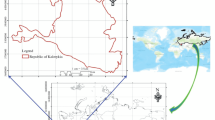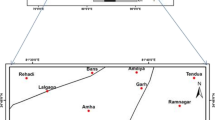Abstract
Remote sensing and geographic information system (GIS) have become one of the leading tools in the field of hydrogeological science, which helps in assessing, monitoring and conserving groundwater resources. In this paper, integrated remote sensing, GIS and fieldwork techniques were combined to delineate the groundwater potential zones map of Devak and Rui watersheds of Jammu and Kashmir. Remote sensing data were used to prepare hydrogeomorphology, drainage density and land use/land cover maps. The advanced space borne thermal emission and reflection (ASTER) digital elevation model (DEM) data was used for preparing the slope map. Pumping test data were used to prepare discharge, specific capacity, static water level, transmissivity and hydraulic conductivity maps. Well inventory data were collected to prepare the pre-monsoon water table, post-monsoon water table, static water level and fluctuation maps. All the thematic maps pertaining to chosen parameters were converted to raster data. The raster maps of these parameters were assigned an appropriate theme weight and class score. All thematic layers were integrated using the weighted index overlay analysis (WIOA) method in the GIS environment to determine groundwater potential map. The ground water prospects zones were depicted in five categories excellent, good, moderate, low and runoff zone. The results revealed that excellent zone covers 13.5 %, good zone 22.7 %, moderate zone 15.8 %, low zone 18.5 %, and runoff zone covers 29.5 % of the total study area. The result depicts the groundwater potential zones found to be helpful in better planning and management of groundwater resources in the study area.






Similar content being viewed by others
References
Aggarwal R, Kaur S, Juyal D (2009) Micro level assessment of water resources in bist doab tract of Indian Punjab. J Agric Eng 46(2):33–39
Adji TN, Sejati SP (2014) Identification of groundwater potential zones within an area with various geomorphological units by using several field parameters and a GIS approach in Kulon Progo Regency, Java, Indonesia. Arab J Geosci 7(1):161–172
Avtar R, Singh CK, Shashtri S, Singh A (2010) Identification and analysis of ground water potential zones in Ken-Betwa river linking area using remote sensing and GIS. Geocarto Int 25(5):379–396
Bocco G, Mendoza M, Velàzquez A (2001) Remote sensing and GIS-based regional geomorphological mapping-tools for land use planning in developing countries. Geomorphology 39:211–219
Bolten A, Bubenzer O (2006) New elevation data (SRTM/ASTER) for geomorphological and geoarchaeological research in arid regions. Zeitschrift für Geomorphologie, Supplementband 142:265–279
Bower H (1978) Groundwater hydrology. Company, McGraw-Hill Book
Briscoe J (2005) India’s water economy: bracing for a turbulent future. Report No. 34750-IN, VIII-XI (World Bank, 2005)
Chawla JK, Khepar SD, Sondhi SK, Yadav AK (2010) Assessment of long-term groundwater behaviour in Punjab, India. Water Int 35(1):63–77
Chenini I, Mammou AB, Moufida EM (2010) Groundwater recharge zone mapping using GIS-based multi-criteria analysis: a case study in Central Tunisia (Maknassy Basin). Water Resour Manag 24(5):921–939
Chowdhury A, Jha MK, Chowdary VM (2010) Delineation of groundwater recharge zones and identification of artificial recharge sites in West Medinipur District, West Bengal using RS, GIS and MCDM techniques. Environ Earth Sci 59(6):1209–1222
Chowdhury A, Jha MK, Chowdary VM, Mal BC (2009) Integrated remote sensing and GIS-based approach for assessing groundwater potential in West Medinipur district, West Bengal, India. Int J Remote Sens 30(1):231–250
Dar IA, Sankar K, Dar MA (2010) Remote sensing technology and geographic information system modeling: An integrated approach towards the mapping of groundwater potential zones in hardrock terrain, Mamundiyar basin. J Hydrol 394:285–295
Demirkesen A (2008) Digital terrain analysis using landsat-7 ETM+ imagery and SRTM DEM: a case study of Nevsehir province (Cappadocia), Turkey. Int J Remote Sens 29(14):4173–4188
El-kadi AI, Oloufa AA, Eltahan AA, Malic HU (1994) Use of a geographic information system in site-specific groundwater modeling. Ground Water 32:617–625
Gahegan M, Ehlers M (2000) A framework for the modelling of uncertainty between remote sensing and geographic information systems. ISPRS J Photogramm Remote Sens 55:176–188
Goyal S, Bharawadaj RS, Jugran DK (1999) Multicriteria analysis using GIS for groundwater resource evaluation in Rawasen and Pilli watershed, U.P. http://www.GISdevelopment.net. Accessed on:17 Dec 2003.
Gumma MK, Pavelic P (2013) Mapping of groundwater potential zones across Ghana using remote sensing, geographic information systems, and spatial modeling. Environ Monit Assess 85:3561–3579
Gupta M, Srivastava PK (2010) Integrating GIS and remote sensing for identification of groundwater potential zones in the hilly terrain of Pavagarh, Gujarat, India. Water Int 35(2):233–245
Gupta SK, Deshpande RD (2004) Water for India in 2050: first order assessment of available options. Curr Sci 86:1216–1224
Hajkowicz S, Collins K (2007) A review of multiple criteria analysis for water resource planning and management. Water Resour Manag 21(9):1553–1566
Jasrotia AS, Kumar R, Saraf AK (2007) Delineation of groundwater recharge sites using integrated remote sensing and GIS in Jammu district. Int J Remote Sens 28:5019–5036
Jasrotia AS, Bhagat BD, Kumar A, Kumar R (2013) Remote sensing and GIS approach for delineation of groundwater potential and groundwater quality zones of Western Doon valley, uttarakhand, India. J Indian Soc Remote Sens 41(2):365–377
Jaiswal RK, Mukherjee S, Krishnamurthy J, Saxena R (2003) Role of remote sensing and GIS techniques for generation of groundwater prospect zones towards rural development-an approach. Int J Remote Sens 24:993–1008
Jha MK, Chowdary VM (2007) Challenges of using remote sensing and GIS in developing nations. Hydrogeol J 15(1):197–200
Jones JAA (2010) Water sustainability: a global perspective. Hodder, London, 452 pp
Joshi PK, Tyagi NK (1994) Salt affected and water logged soils in India: a review. In: Svendsen M, Gulati A (eds) Strategic change in Indian irrigation. ICAR and IFPRI, New Delhi, India and Washington, DC, USA, pp. 237–252
Kaliraj S, Chandrasekar N, Magesh NS (2014) Identification of potential groundwater recharge zones in Vaigai upper basin, Tamil Nadu, using GIS-based analytical hierarchical process (AHP) technique. Arab J Geosci 7:1385–1401
Krishnamurthy J, Srinivas G (1995) Role of geological and geomorphological factors in groundwater exploration. A study using IRS LISS II data. Int J of Remote Sens 16:2595–2618
Krishnamurthy JV, Kumar N, Jayaraman V, Manivel M (1996) An approach to demarcate groundwater potential zones through remote sensing and a geographical information system. Int J of Remote Sens7 (12):1867–1884
Kumar R, Singh RD, Sharma KD (2005) Water resources of India. Curr Sci 89:794–811
Magesh NS, Chandrasekar N, Soundranayagam JP (2012) Delineation of groundwater potential zones in Theni district, Tamil Nadu, using remote sensing, GIS and MIF techniques. Geosci Front 3(2):189–196
Mallick J, Singh CK, Al-wadi H, Ahmed M, Rahman A, Shashtri S, Mukherjee S (2015) Geospatial and geostatistical approach for groundwater potential zone delineation. Hydrol Process 29:395–418
Manap AM, Sulaiman WNA, Ramli MF, Pradhan B, Surip N (2013) A knowledge-driven GIS modeling technique for groundwater potential mapping at the Upper Langat Basin, Malaysia. Arab J Geosci 6:1621–1637
Manap AM, Nampak H, Pradhan B, Lee S, Sulaiman WNA, Ramli MF (2014) Application of probabilistic-based frequency ratio model in groundwater potential mapping using remote sensing data and GIS. Arab J Geosci 7(2):711–724
Mesev V, Walrath A (2007) GIS and remote sensing integration: in search of a definition. In: Mesev V (ed) Integration of GIS and Remote Sensing. Wiley, Chichester, pp. 1–13
Murthy KSR (2000) Groundwater potential in a semiarid region of Andhra Pradesh: a geographical information system approach. Int J Remote Sens 21(9):1867–1884
Murthy KSR, Mamo AG (2009) Multi-criteria decision evaluation in groundwater zones identification in Moyale-Teltele sub-basin, South Ethiopia. Int J Remote Sens 30(11):2729–2740
Obi R, Chandra GP, Mouli K, Srivastav SK, Srinivas CV, Maji AK (2000) Evaluation of groundwater potential zones using remote sensing data -a case study of Gaimukh watershed, Bhandara district, Maharashtra. J Indian Soc Remote Sens 28(1):19–32
Pedrero F, Albuquerque A, Marecos do Monte H, Cavaleiro V, Alarcon JJ (2011) Application of GIS-based multi-criteria analysis for site selection of aquifer recharge with reclaimed water. Resour Conserv Recycl 56 (1):105–116
Pothiraj P, Rajagopalan B (2013) A GIS and remote sensing based evaluation of groundwater potential zones in a hard rock terrain of Vaigai sub-basin, India. Arab J Geosci 6:2391–2407
Pradhan B (2009) Groundwater potential zonation for basaltic watersheds using satellite remote sensing data and GIS techniques. Cent Eur J Geosci 1(1):120–129
Prasad RK, Mondal NC, Banerjee P, Nandakumar MV, Singh VS (2008) Deciphering potential groundwater zone in hard rock through the application of GIS. Environ Geol 55:467–475
Rahmati O, Samani AN, Mahdavi M, Pourghasemi HR, Zeinivand H (2015) Groundwater potential mapping at Kurdistan region of Iran using analytic hierarchy process and GIS. Arab J Geosci 8(9):7059–7071
Rao YS, Jugran DK (2003) Delineation of groundwater potential zones and zones of groundwater quality suitable for domestic purposes using remote sensing and GIS. Hydrol Sci J 48:821–833
Reddy PR, Vinod Kumar K, Seshadri K (1996) Use of IRS-1C data in groundwater studies. Curr Sci 70:600–605
Rodell M, Velicogna I, Famiglietti JS (2009) Satellite-based estimates of groundwater depletion in India. Nature 460:999–1002
Rokade VM, Kundal P, Joshi AK (2007) Groundwater potential modeling through remote sensing and GIS: a case study from Rajura Taluka, Chandrapur District, Maharashtra. J Geol Soc India 69:943–948
Sander P, Chesley MM, Minor TB (1996) Groundwater assessment using remote sensing and GIS in a rural groundwater project in Ghana: lessons learned. Hydrogeol J 4:40–49
Saraf AK, Choudhary ER (1998) Integrated remote sensing and GIS for ground water exploration and identification of artificial recharge sites. Int J Remote Sens 19(10):1825–1841
Shahid S, Nath SK, Roy J (2000) Ground water potential modeling in soft rock area using GIS. Int J Remote Sens 21(9):1919–1924
Singh P, Thakur JK, Kumar S (2013) Delineating groundwater potential zones in a hard-rock terrain using geospatial tool. Hydrol Sci J 58(1):213–223
Teeuw RM (1995) Groundwater exploration using remote sensing and a low-cost geographical information system. Hydrogeol J 3:21–30
Thakur GS, Raghuwanshi RS (2008) Prospect and assessment of groundwater resources using remote sensing techniques in and around Choral River basin, Indore and Khargone districts. J Indian Soc Remote Sens 36(2):217–225
Walsh S, Butler D, Malanson G (1998) An overview of scale, pattern, process relationships in geomorphology: a remote sensing and GIS perspective. Geomorphology 21:183–205
Acknowledgments
The authors are thankful to the Central Groundwater Board (CGWB), North Western Himalaya Region, Jammu for pumping test data. The authors also equally thank Head, Department of Geology and Department of Remote Sensing & GIS, University of Jammu, for support in providing the necessary facilities and encouragement to carry out the present work. We express our sincere gratitude to the three anonymous reviewers for evaluating the research paper critically; their valuable suggestions improved the quality of this manuscript.
Author information
Authors and Affiliations
Corresponding author
Rights and permissions
About this article
Cite this article
Jasrotia, A.S., Kumar, A. & Singh, R. Integrated remote sensing and GIS approach for delineation of groundwater potential zones using aquifer parameters in Devak and Rui watershed of Jammu and Kashmir, India. Arab J Geosci 9, 304 (2016). https://doi.org/10.1007/s12517-016-2326-9
Received:
Accepted:
Published:
DOI: https://doi.org/10.1007/s12517-016-2326-9




